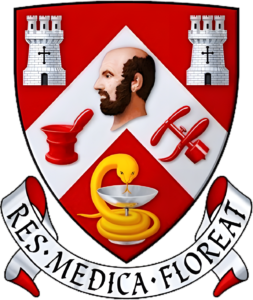John Mallard OBE FRSE
 John Rowland Mallard was born in Kingsthorpe, Northampton. He studied physics at the University College Nottingham, completing a PhD on the magnetic properties of uranium in 1951. In 1953, he was appointed senior physicist in the Royal Postgraduate Medical School, University of London, becoming head of department in 1957. At the Hammersmith Hospital, John Mallard built the first radionuclide imaging device in the UK and was involved in the first European brain tumour imaging trials. He developed an electron spin resonance (ESR) spectrometer and showed that ESR signals from normal tissue were different from those from tumours. Publication in the journal Nature in 1964, went largely unnoticed.
John Rowland Mallard was born in Kingsthorpe, Northampton. He studied physics at the University College Nottingham, completing a PhD on the magnetic properties of uranium in 1951. In 1953, he was appointed senior physicist in the Royal Postgraduate Medical School, University of London, becoming head of department in 1957. At the Hammersmith Hospital, John Mallard built the first radionuclide imaging device in the UK and was involved in the first European brain tumour imaging trials. He developed an electron spin resonance (ESR) spectrometer and showed that ESR signals from normal tissue were different from those from tumours. Publication in the journal Nature in 1964, went largely unnoticed.
In 1965, Mallard moved to Aberdeen as Professor of Medical Physics, the first such chair in Scotland. Prof. Mallard and Jim Hutchison built a prototype MRI scanner and successfully scanned a dead mouse in 1975. An MRC grant enabled the team to design and build a human-sized MRI scanner, based on a 0.04 tesla magnet. The first patient was scanned on 28 August 1980. A fundamental step was a technique, known as spin-warp imaging, that could produce three-dimensional images unaffected by the movement of patients. The Mark 1 scanner, the world’s first working whole-body MRI scanner is now on display in the Suttie Art Space in Aberdeen Royal Infirmary (documentary on the History of MRI).
A number of “Mark 2” scanners followed, with 0.08 tesla magnetic field strength. One is now in the Royal Scottish Museum in Edinburgh, and another in the Science Museum in London. Production scanners based on the Mark 2 design were built and sold by Asahi in Japan.
Mallard led the Medical Physics department developing techniques which have become standard in health care throughout the world including Radionuclide Imaging, Magnetic Resonance Imaging (MRI) and Positron Emission Tomography.
Mallard retired in 1992 and was awarded an OBE in the same year. He was made an honorary freeman of the city of Aberdeen in 2004 and a hereditary freeman of the borough of Northampton in October 2018.
Aberdeen’s Role in the Development of Magnetic Resonance Imaging
Awards
Fellow of the Royal Society of Edinburgh
Fellow of the Royal Academy of Engineering
Freedom of the City of Aberdeen in 2004
Royal Society Wellcome Prize and Gold Medal
George von Hevesy Memorial Lecture Medal
Royal Medal of the Royal Society of Edinburgh
Landau Memorial Plaque of the American Association of Physicists in Medicine
Academic Enterprise Competition Prize of the British Technology Group
The team has received many awards. Prof Mallard has donated his medals to the Aberdeen Medico-Chirurgical Society – slide show of medals
The University of Aberdeen hosted a celebration of Professor Mallard’s life on Saturday 19 August in the King’s College Chapel. You can watch a recording.
Obituary/Biography:
The Times
International Organization for Medical Physics
Wikipedia
Image: © University of Aberdeen
14 January 1927 – 25 February 2021


